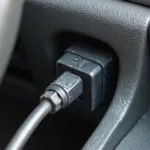Monitoring your tire pressure is crucial for safety, fuel efficiency, and tire longevity. Using Torque OBD2 for tire pressure monitoring offers a convenient and cost-effective solution. This guide will delve into the intricacies of using Torque OBD2 to monitor your tire pressure, offering valuable insights and practical tips.
Torque OBD2 offers a versatile platform for monitoring various vehicle parameters, including tire pressure, when paired with a compatible TPMS (Tire Pressure Monitoring System). While not all vehicles transmit tire pressure data via the OBD2 port, many modern cars do, making Torque OBD2 a viable option for real-time tire pressure monitoring. For vehicles that don’t transmit TPMS data via OBD2, external TPMS solutions can be integrated with Torque. Let’s explore how you can benefit from this technology.
Understanding Torque OBD2 and Tire Pressure
Torque OBD2 is a powerful diagnostic and monitoring tool that connects to your vehicle’s OBD2 port, providing access to a wealth of data, sometimes including tire pressure. To monitor tire pressure with Torque OBD2, you need a Bluetooth OBD2 adapter and the Torque app installed on your smartphone or tablet. Understanding how these components work together is essential.
How Does it Work?
The OBD2 adapter acts as a bridge between your car’s computer and your smart device. It reads the data transmitted from the vehicle’s sensors, including the TPMS sensors if they communicate via OBD2, and sends it to the Torque app. The app then interprets this data and displays it in a user-friendly format.
What’s the differences between a tuner and obd2 scanner? This is a common question among car enthusiasts. While both interface with the OBD2 port, they serve distinct purposes. A tuner modifies the vehicle’s engine control unit (ECU), while an OBD2 scanner primarily retrieves diagnostic information.
Benefits of Using Torque OBD2 for Tire Pressure Monitoring
Using Torque OBD2 for tire pressure monitoring offers several advantages:
- Real-time Monitoring: Get instant updates on your tire pressure while driving, allowing you to address any issues promptly.
- Cost-Effective: Compared to dedicated TPMS systems, using Torque OBD2 offers a significantly more affordable solution.
- Enhanced Safety: Properly inflated tires improve handling, braking, and overall safety.
- Improved Fuel Economy: Underinflated tires increase rolling resistance, leading to reduced fuel efficiency. By monitoring and maintaining correct tire pressure, you can optimize your fuel economy.
- Extended Tire Life: Correctly inflated tires wear more evenly, extending their lifespan.
Is Torque OBD2 compatible with all cars?
While Torque OBD2 works with most modern vehicles, compatibility with TPMS over OBD2 varies. Check your vehicle’s manual or consult online forums to determine if your car transmits tire pressure data through the OBD2 port.
Setting Up Torque OBD2 for Tire Pressure
Setting up Torque OBD2 for tire pressure monitoring is a straightforward process:
- Install the Torque App: Download and install the Torque app from the Google Play Store or Apple App Store.
- Connect the OBD2 Adapter: Plug the Bluetooth OBD2 adapter into your vehicle’s OBD2 port.
- Pair with Your Device: Pair the adapter with your smartphone or tablet via Bluetooth.
- Configure the App: Within the Torque app, configure the settings to display tire pressure readings. You may need to download specific plugins or customize the display to show TPMS data.
Troubleshooting Torque OBD2 Tire Pressure Monitoring
Sometimes, you may encounter issues with Torque OBD2 tire pressure monitoring. Here are some common problems and solutions:
- No Tire Pressure Data: If the app doesn’t display any tire pressure data, ensure your vehicle transmits TPMS information via OBD2. If it does, check the OBD2 adapter’s connection and the app’s configuration.
- Inaccurate Readings: Inaccurate readings can be caused by faulty sensors, a weak battery in the TPMS sensor, or interference from other electronic devices.
- Connection Issues: If you experience connection problems between the adapter and your device, try restarting both devices or re-pairing them.
Conclusion
Using Torque OBD2 to monitor your torque obd2 tire pressure is a smart and economical way to enhance safety, improve fuel economy, and extend tire life. While compatibility varies, the potential benefits make it a worthwhile exploration for any car owner. By understanding how the system works and following the setup instructions, you can easily leverage the power of Torque OBD2 for tire pressure monitoring.
Expert Insight from John Smith, Automotive Engineer: “Torque OBD2 offers a cost-effective way to access valuable vehicle data, including tire pressure for compatible vehicles. It empowers drivers to take a proactive approach to vehicle maintenance and safety.”
Expert Insight from Maria Garcia, Certified Mechanic: “Regularly monitoring tire pressure is essential for optimal vehicle performance and safety. Torque OBD2 provides a convenient way to track this crucial parameter.”
obd2 mpg provides insights into fuel efficiency. super obd2 fuel saver claims to optimize fuel consumption, while understanding nitro obd2 dyno can enhance performance analysis. Finally, if you’re experiencing issues with a specific error code like obd2 code p061b, resources are available to help you diagnose and resolve the problem.
If you need further assistance, please contact us via WhatsApp: +1(641)206-8880, Email: [email protected] or visit us at 789 Elm Street, San Francisco, CA 94102, USA. Our 24/7 customer support team is ready to help.
